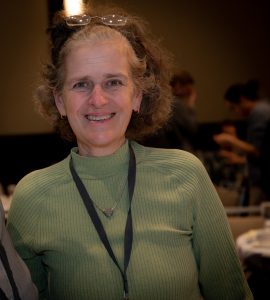13 June 2019–If you don’t know who Bailey Willis and Robert T. Hill are, Susan Hough has got a book for you. It’s her own book, actually—one that she’s working on now, about the period between 1906 and 1933, when earthquake hazard for the Los Angeles area was being debated by Willis and Hill against the backdrop of the booming metropolitan area.
As Hough has been researching the book, “it has turned into intertwined biographies, intertwined life trajectories” of Willis and Hill, both field geologists. “It’s largely about how personalities and individuals shaped these debates,” she says. “And it has a lot of issues that I think are relevant now, including how we communicate about hazard.”
Hough says research for the book—like some of her research on historical seismology—has been like a treasure hunt, especially when the trail takes her into the archives for correspondence and other papers that aren’t readily available online. “I might be the only seismologist around who writes for fun in my spare time,” she says. “It’s my biggest hobby.”

By day Hough is a research geophysicist, and she began her term as SSA President in April this year. And she’s the author of five books, covering topics as varied as earthquake prediction and a tourist’s guide to earthquakes in California, along with a biography of famed seismologist Charles Richter.
Historical seismology was something she “fell into by accident,” she says, while doing background research on the 1812 New Madrid earthquake for a book. Since then, she has studied historical earthquakes in California, Oklahoma and India, among other places.
“I’ve called it the Rodney Dangerfield of seismology,” Hough says of historical seismology, “because it sometimes feels like it gets no respect.”
However, the topic has become increasingly popular among seismologists, as a recent session at the 2019 SSA Annual Meeting in Seattle demonstrated. “I think it’s because we know now that it’s not just about historical characterization,” says Hough. “We have different types of data from historical earthquakes, and increasingly, scientists are finding clever ways to exploit them.” She pointed to work by California State University-Northridge researcher Julian Lozos, for example, who is studying dynamic rupture modeling with the help of historic observations, as well as work by researchers at Northwestern University to use historically observed intensities as a test of probabilistic seismic hazard maps.
Seismology was not a lifelong ambition for Hough, who says she grew up loving two subjects: math and writing. “I never felt an earthquake until I was an undergraduate” at University of California, Berkeley, she says, where she initially thought she might major in math or computer science or astronomy.
Role models were few and far between in those fields. “I didn’t have a single female professor as an undergrad or as a graduate student in any STEM field,” she recalls. Mathematics especially seemed like a different world. “I think, looking back, I might have had the sense that it wasn’t a community I saw myself being part of.”
A perusal of the Berkeley course catalog led Hough to geophysics. “I liked the idea that it was relevant, and that it offered more of a career path than say, math or astronomy,” she says.
Hough comes to the SSA presidency after serving many roles in the society, including as a member of the Board of Directors, Communications, Publications and Government Relations Committees, and as a former editor-in-chief of Seismological Research Letters.
One of her priorities for her presidential year, Hough says, is to increase the Society’s support for student and early-career members, and especially to connect directly with these members “to hear directly about their challenges.” She also hopes to work on ways to grow SSA membership.
“Back in 1920, Bailey Willis [SSA president from 1921 to 1926] wrote letters trying to broaden and increase the [SSA] membership. He argued that there aren’t many seismologists in the world but there are a lot of people who are interested in earthquakes, and why shouldn’t they be members?” says Hough. “The same question occurs to me.”
Hough also wants to speak directly to SSA members about why their membership is valuable. “I would like to try to reframe the question in people’s minds, getting away from casting it in terms of, ‘what am I getting out of this money each year?’” she says. “I pay my membership dues because SSA supports the causes that I care about, and the issues that I’ve devoted my career to.”
SSA’s support of seismological research through its journals and Annual Meeting, support of relevant public policy like the National Earthquake Hazards Reduction Program and support for future generations of seismologists through programs such as its student travel grants, are all part of the “case” she makes for SSA membership.
“SSA supports seismology and risk reduction; it’s a cause that is near and dear to all of our hearts,” she says.





修改评论